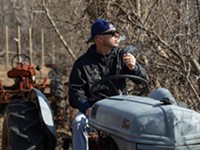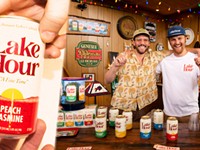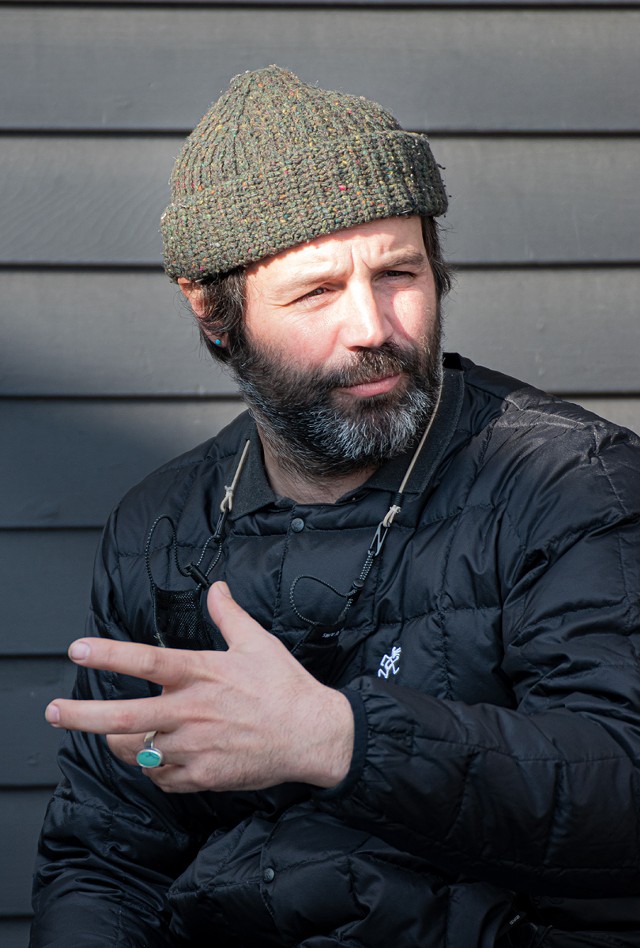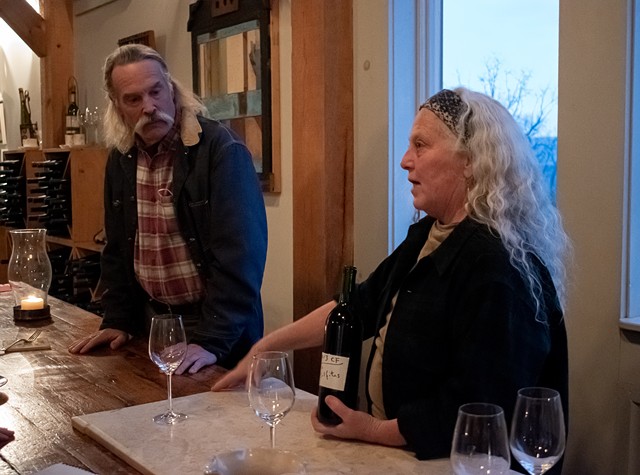[
{
"name": "500x250 Ad",
"insertPoint": "5",
"component": "15667920",
"parentWrapperClass": "",
"requiredCountToDisplay": "1"
}
]
Wine to many everyday Americans has long been synonymous with snobbery. Oenophiles do nothing to soften that perception when they crow about their oaked cabernets emitting notes of leather and graphite and the lushness of the fruit in their cellar-aged Burgundy.
But great wine is not pretentious. There is nothing conceited about the soil or the rain or the dedicated craftsmen who work vineyards from sunrise to sunset during harvest when the weather turns that go into a bottle worth celebrating.
Wine at its core is an agricultural product born of passion and the elements.
For the last few years, Brandon Opalich, the owner of Aldaskeller Wine Company and a former longtime restaurant worker, has sought to introduce people to the passion and the elements through pop-up events that pair natural wines with food curated by his business partner, Tim Benedict.
Natural wines, a trend that’s sweeping the wine world, are those made with organic grapes and fermented and aged without additives, like sulfites. They are what Opalich calls “hands-off, low-intervention” wines, unlike many mainstream wines that are produced like processed foods, with artificial ingredients to achieve a desired aroma and flavor.
Beer-minded readers could think of natural wine like a wild ale. They eschew preservatives, cultured yeasts, and complex refining techniques in favor of two simple ingredients: grapes and time.
Now, Aldaskeller is poised to open a brick-and-mortar shop on Gregory Street in the South Wedge that will focus exclusively on offering natural wines. Opalich hopes to open in March, pending approval of a state license to sell wine.
“Natural wines are a very good representation of terroir,” Opalich said. “It’s a concept in wine that essentially means the taste of the place — the soil, the environment, the climate, the yeast that’s being used — that all goes into making the final product.”
Aldaskeller — a portmanteau of Opalich’s great-aunt’s name and the German word for cellar — aims to be as much of a wine shop as an educational forum.
“I want people to come in and get the wines they love and what they’re familiar with,” Opalich said. “But I’m also bringing in really fun, unfamiliar wines that they’re not going to be able to get anywhere else.”
The natural wine trend has been fueled by a cultural shift towards small batch, artisanal beverages and the endorsement of trendsetters along the lines of Bon Appetit wine columnist Marissa Ross and rapper, chef, and foodie Action Bronson. Upon accepting her job in 2015, Ross vowed to only write about natural wines. Bronson is known as much for his verses as his show, “Fuck, That's Delicious.”
But the popularity of the style owes largely to its delicate layers of flavors, which winemakers have argued would be impossible to mass produce. Drinkers have also reported that the wines, which tend to be lower alcohol, don’t leave them with hangovers, although scant credible research has been done on the claim.
To best understand the philosophy behind natural wine, a visit to a natural winery is a must.
Bloomer Creek, a rustic hardwood winery a few hundred feet inland from the southeastern shore of Seneca Lake, is owned by husband and wife Kim Engle and Debra Bermingham. A former art professor at Cornell University, Bermingham’s dreamy still life paintings adorn the winery’s walls.
Together, they churn out limited batches of spontaneously fermented wines. That means they leave the inoculation — the moment the yeast and bacteria come in contact with the liquid — up to whatever organisms happen to be in the air or on the grapes being fermented.
Engle entered the wine world in 1978 working the vineyards surrounding Cayuga Lake during a frosty harvest. He and Bermingham opened Bloomer Creek in 1999.
“I would say we started fooling with spontaneous fermentations in around 2006 or 2007,” Engle said. “There seemed to be interest around the industry at that time, but because when you first do it, there’s a lot of volatile compounds produced, it makes a lot of conventional winemakers nervous, and they all backed off.”
For a two-person operation pumping out 2,000 cases per year, Bloomer Creek has made a splash.
Last year, New York Times wine critic Eric Asimov ranked the winery’s White Horse Red in the top 10 of New York wines. That same year, Times restaurant critic Pete Wells toted a bottle of Bloomer Creek’s 2018 Riesling to an annual pre-Thanksgiving food-and-drink writer meal. In 2014, The Village Voice heralded Bloomer Creek as “hallowed ground.”
The accolades are deserved. Over samples of goat cheese from nearby Lively Run Dairy Farm, Engle and Bermingham poured tastes of three of their offerings.
Their age-defying 2013 cabernet franc burst with a fresh, sweet cherry overtone ahead of a mild oakiness and a mouth-drying finish of tannins. The riesling and gewurztraminer blend “orange wine” balanced a pleasant funkiness atop a juicy, pithy blend of nuanced notes. The riesling Pétillant Naturel, a light sparkling natural wine, offered a subtle sweetness undercut with notes of peach and nectarine against a backdrop of ethereal funk from the wild yeast.
“This is how wine used to be made before everybody got involved with sort of interfering with it,” Bermingham said.
At Aldaskeller, Opalich aims to capture some of that magic.
“We want to cultivate an environment where people are coming in and learning as much as they can, and hopefully I learn something from them too,” Opalich said.
“That’s really the beauty of it all.”
Gino Fanelli is a CITY staff writer. He can be reached at (585) 775-9692 or [email protected].
But great wine is not pretentious. There is nothing conceited about the soil or the rain or the dedicated craftsmen who work vineyards from sunrise to sunset during harvest when the weather turns that go into a bottle worth celebrating.
Wine at its core is an agricultural product born of passion and the elements.
For the last few years, Brandon Opalich, the owner of Aldaskeller Wine Company and a former longtime restaurant worker, has sought to introduce people to the passion and the elements through pop-up events that pair natural wines with food curated by his business partner, Tim Benedict.
Natural wines, a trend that’s sweeping the wine world, are those made with organic grapes and fermented and aged without additives, like sulfites. They are what Opalich calls “hands-off, low-intervention” wines, unlike many mainstream wines that are produced like processed foods, with artificial ingredients to achieve a desired aroma and flavor.
Beer-minded readers could think of natural wine like a wild ale. They eschew preservatives, cultured yeasts, and complex refining techniques in favor of two simple ingredients: grapes and time.
Now, Aldaskeller is poised to open a brick-and-mortar shop on Gregory Street in the South Wedge that will focus exclusively on offering natural wines. Opalich hopes to open in March, pending approval of a state license to sell wine.
“Natural wines are a very good representation of terroir,” Opalich said. “It’s a concept in wine that essentially means the taste of the place — the soil, the environment, the climate, the yeast that’s being used — that all goes into making the final product.”
Aldaskeller — a portmanteau of Opalich’s great-aunt’s name and the German word for cellar — aims to be as much of a wine shop as an educational forum.
“I want people to come in and get the wines they love and what they’re familiar with,” Opalich said. “But I’m also bringing in really fun, unfamiliar wines that they’re not going to be able to get anywhere else.”
The natural wine trend has been fueled by a cultural shift towards small batch, artisanal beverages and the endorsement of trendsetters along the lines of Bon Appetit wine columnist Marissa Ross and rapper, chef, and foodie Action Bronson. Upon accepting her job in 2015, Ross vowed to only write about natural wines. Bronson is known as much for his verses as his show, “Fuck, That's Delicious.”
But the popularity of the style owes largely to its delicate layers of flavors, which winemakers have argued would be impossible to mass produce. Drinkers have also reported that the wines, which tend to be lower alcohol, don’t leave them with hangovers, although scant credible research has been done on the claim.
To best understand the philosophy behind natural wine, a visit to a natural winery is a must.
Bloomer Creek, a rustic hardwood winery a few hundred feet inland from the southeastern shore of Seneca Lake, is owned by husband and wife Kim Engle and Debra Bermingham. A former art professor at Cornell University, Bermingham’s dreamy still life paintings adorn the winery’s walls.
Together, they churn out limited batches of spontaneously fermented wines. That means they leave the inoculation — the moment the yeast and bacteria come in contact with the liquid — up to whatever organisms happen to be in the air or on the grapes being fermented.
Engle entered the wine world in 1978 working the vineyards surrounding Cayuga Lake during a frosty harvest. He and Bermingham opened Bloomer Creek in 1999.
“I would say we started fooling with spontaneous fermentations in around 2006 or 2007,” Engle said. “There seemed to be interest around the industry at that time, but because when you first do it, there’s a lot of volatile compounds produced, it makes a lot of conventional winemakers nervous, and they all backed off.”
For a two-person operation pumping out 2,000 cases per year, Bloomer Creek has made a splash.
Last year, New York Times wine critic Eric Asimov ranked the winery’s White Horse Red in the top 10 of New York wines. That same year, Times restaurant critic Pete Wells toted a bottle of Bloomer Creek’s 2018 Riesling to an annual pre-Thanksgiving food-and-drink writer meal. In 2014, The Village Voice heralded Bloomer Creek as “hallowed ground.”
The accolades are deserved. Over samples of goat cheese from nearby Lively Run Dairy Farm, Engle and Bermingham poured tastes of three of their offerings.
Their age-defying 2013 cabernet franc burst with a fresh, sweet cherry overtone ahead of a mild oakiness and a mouth-drying finish of tannins. The riesling and gewurztraminer blend “orange wine” balanced a pleasant funkiness atop a juicy, pithy blend of nuanced notes. The riesling Pétillant Naturel, a light sparkling natural wine, offered a subtle sweetness undercut with notes of peach and nectarine against a backdrop of ethereal funk from the wild yeast.
“This is how wine used to be made before everybody got involved with sort of interfering with it,” Bermingham said.
At Aldaskeller, Opalich aims to capture some of that magic.
“We want to cultivate an environment where people are coming in and learning as much as they can, and hopefully I learn something from them too,” Opalich said.
“That’s really the beauty of it all.”
Gino Fanelli is a CITY staff writer. He can be reached at (585) 775-9692 or [email protected].
Latest in What Ales me
More by Gino Fanelli
-

These small cannabis farmers say New York's legal weed rollout is ruining their lives
Mar 21, 2024 -

Man shakes fist at sun
Mar 15, 2024 -

Finger Lakes in a can, by way of Hollywood
Feb 13, 2024 - More »






